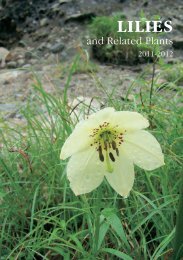LILIES - RHS Lily Group
LILIES - RHS Lily Group
LILIES - RHS Lily Group
You also want an ePaper? Increase the reach of your titles
YUMPU automatically turns print PDFs into web optimized ePapers that Google loves.
the opinion of the Committee, had done more than those of any other writer to<br />
maintain and increase interest in lilies”.<br />
The 1939-45 war caused a hiatus in the publication of the Year Book and a<br />
general winding down of the activities of the Committee which met annually<br />
for the duration. After the war business continued as usual, still under the<br />
Chairmanship of Sir Frederick Stern who was now the holder of the <strong>RHS</strong> Victoria<br />
Medal of Honour. In 1949 Committee played a part in organising a trial of lilies at<br />
Wisley. In response to an enquiry from Jan de Graaff in Oregon, it was decreed<br />
that bulbs for the trial must have been propagated vegetatively and not grown<br />
from seed. Thus the whole range of de Graaff’s burgeoning strains of trumpet<br />
lilies were excluded despite their singular significance in the future development<br />
of the lily as a garden plant. Bulbs accepted for the trial were tested for cucumber<br />
mosaic virus at intervals by inoculation of test plants with sap from the scales and<br />
later the leaves. They were grown well away from herbaceous plants and weeds<br />
and were sprayed with nicotine twice weekly.<br />
The first post-war <strong>Lily</strong> Conference was held in 1959 with the organisation<br />
largely in the hands of the <strong>RHS</strong> itself. At the accompanying show Oliver Wyatt,<br />
Major and Mrs Knox-Finlay of Keillour Castle and Oregon Bulb Farms (Jan de<br />
Graaff) were among those showing lilies, but no Gold Medals were awarded.<br />
The still new de Graaff trumpet lily ‘Limelight’, already a holder of the Award<br />
of Merit, was given a First Class Certificate. Reports of strong stems of Lilium<br />
lankongense, L. cernuum and L. taliense on the de Graaff stand remind us that<br />
it was not only hybrid development which was lost with the eventual demise of<br />
his Oregon Bulb Farms.<br />
The fourth Conference was duly held in 1969. During the intervening ten<br />
years, two new species lilies had been described – Lilium rhodopeum and<br />
L. ciliatum. Three Gold Medals were awarded at the accompanying show: to<br />
Geest Industries showing de Graaff lilies; to the Dutch <strong>Lily</strong> Society and to the<br />
<strong>RHS</strong> <strong>Lily</strong> <strong>Group</strong>.<br />
In the intervening years the greatest change, of course, was the death of<br />
Sir Frederick Stern in 1967. Though not always abreast of the times in his<br />
approach, he left a void which proved almost impossible to fill. In all the<br />
Standing Committees of the <strong>RHS</strong>, the Chairman is appointed by the Council and<br />
expected to be either a member or former member of Council. Oliver Wyatt was<br />
appointed Chairman in 1968, to be succeeded by Miss Frances Perry in 1974.<br />
If the records of the minutes are anything to go by, the meetings of the <strong>Lily</strong><br />
Committee, still held only annually, became progressively shorter. Certainly the<br />
minutes tell virtually nothing of what transpired beyond the annual award of the<br />
Lyttel Cup. There were rumblings of discontent and we hear, now, of division of<br />
the Committee into two factions.<br />
33




